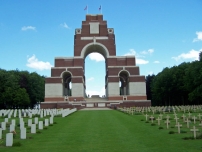| First Name: | George | Last Name: | WOODWARD | |
|---|---|---|---|---|
| Date of Death: | 15/09/1916 | Lived/Born In: | Roehampton | |
| Rank: | Private | Unit: | Royal West Kent11 | |
| Memorial Site: | Thiepval Memorial, France | |||
Current Information:Born-Kennington 5, High Street, Roehampton
The Battle of the Somme (July-November, 1916) By the beginning of September, 1916, the Battle of the Somme had been raging for two months. Thousands of men had already been killed or wounded or were simply missing, never to be seen again and and just a few square miles of the French countryside, all in the southern part of the battlefield, had been captured from the enemy. Mistakes had been made by the various commanders and would be continued to be made but there was no turning back as the British, Australians, South Africans, New Zealanders and Canadians carried on battering away at the German defences in the hope of a breakthrough, So it continued all the way through to November with nearly every battalion and division then in France being drawn into it at some stage. In the end the German trenches had been pushed back a few more miles along most of the line but the cost in lives had been staggering. By the end of the fighting in November, 1916, British Army casualties numbered over 400,000, killed, wounded and missing. On 15th September, 1916, the offensive on the Somme was renewed with a full scale attack on the German 3rd line of defences. Four Army Corps were used on a front that stretched from Combles, through the village of Flers and on to Courcelette. The artillery barrage that preceded this attack was more concentrated than that on 1st July and the attack itself was more successful. The villages of Flers, Martinpuich and Courcelette were captured and the enemy was finally pushed out of High Wood, but the breakthrough was not achieved and the reality was that when the battle ended on 22nd September, the front line had just been moved forward a mile or so. The battle is notable for being the first time that tanks were used. 41st Division attacked the village of Flers on 15th September. They had ten tanks attached for this operation, seven of which made it to the starting line. On the left of the divisional front, 122 Brigade attacked with 15th Hampshire and 18th King’s Royal Rifle Corps followed closely by 11th Royal West Kent and 12th East Surrey. Advancing behind an excellent artillery barrage they swept over Tea Support Trench and, using smoke bombs to clear dug-outs, they had taken the first objective within 20 minutes. The casualties among all four battalions began to mount as they pushed on to the second objective, the Flers line but this was soon taken as enemy resistance weakened. Many prisoners were captured and by 10am, the whole of the village of Flers was in British hands. But by now the casualty figure had risen alarmingly, especially among officers and only a few isolated groups managed to push on to the third objective. The success of capturing Flers came at a heavy price for 41st Division. Among the many who lost their lives was George Woodward of 11th Royal West Kent. |
||||
| « Back to Search Results | ||||
| If you think any of the information shown here is incorrect, Click Here to submit your amends and comments | ||||




